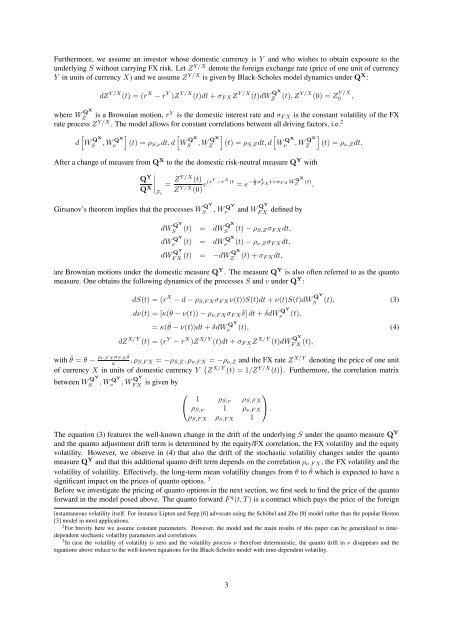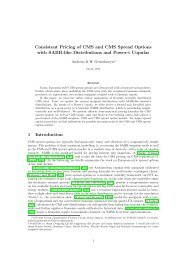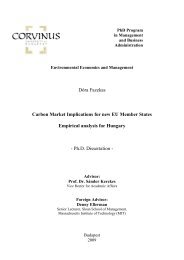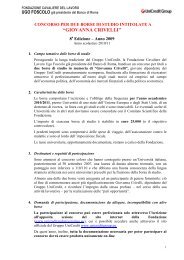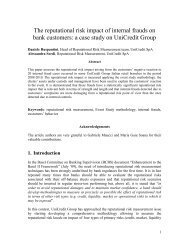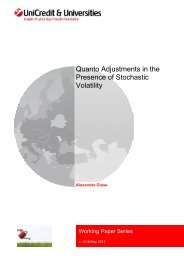Quanto Adjustments in the Presence of Stochastic Volatility
Quanto Adjustments in the Presence of Stochastic Volatility
Quanto Adjustments in the Presence of Stochastic Volatility
You also want an ePaper? Increase the reach of your titles
YUMPU automatically turns print PDFs into web optimized ePapers that Google loves.
Fur<strong>the</strong>rmore, we assume an <strong>in</strong>vestor whose domestic currency is Y and who wishes to obta<strong>in</strong> exposure to <strong>the</strong><br />
underly<strong>in</strong>g S without carry<strong>in</strong>g FX risk. Let Z Y/X denote <strong>the</strong> foreign exchange rate (price <strong>of</strong> one unit <strong>of</strong> currency<br />
Y <strong>in</strong> units <strong>of</strong> currency X) and we assume Z Y/X is given by Black-Scholes model dynamics under Q X :<br />
dZ Y/X (t) = (r X − r Y )Z Y/X (t)dt + σF XZ Y/X (t)dW QX<br />
Z (t), ZY/X (0) = Z Y/X<br />
0<br />
where W QX<br />
Z is a Brownian motion, rY is <strong>the</strong> domestic <strong>in</strong>terest rate and σF X is <strong>the</strong> constant volatility <strong>of</strong> <strong>the</strong> FX<br />
rate process ZY/X . The model allows for constant correlations between all driv<strong>in</strong>g factors, i.e. 2<br />
�<br />
d W QX<br />
�<br />
�<br />
QX<br />
S , Wν (t) = ρS,νdt, d W QX<br />
�<br />
�<br />
QX<br />
S , WZ (t) = ρS,Zdt, d W QX<br />
ν , W QX<br />
�<br />
Z (t) = ρν,Zdt.<br />
After a change <strong>of</strong> measure from QX to <strong>the</strong> <strong>the</strong> domestic risk-neutral measure QY with<br />
QY QX �<br />
�<br />
�<br />
� =<br />
Ft<br />
ZY/X (t)<br />
ZY/X (0) e(rY −r X )t −<br />
= e 1<br />
2 σ2<br />
F X t+σF X W QX<br />
Z (t) ,<br />
Girsanov’s <strong>the</strong>orem implies that <strong>the</strong> processes W QY<br />
S , W QY<br />
ν and W QY<br />
F X def<strong>in</strong>ed by<br />
dW QY<br />
S (t) = dW QX<br />
S (t) − ρS,ZσF Xdt,<br />
dW QY<br />
ν (t) = dW QX<br />
ν (t) − ρν,ZσF Xdt,<br />
dW QY<br />
QX<br />
F X (t) = −dWZ (t) + σF Xdt,<br />
are Brownian motions under <strong>the</strong> domestic measure Q Y . The measure Q Y is also <strong>of</strong>ten referred to as <strong>the</strong> quanto<br />
measure. One obta<strong>in</strong>s <strong>the</strong> follow<strong>in</strong>g dynamics <strong>of</strong> <strong>the</strong> processes S and v under Q Y :<br />
dS(t) = (r X − d − ρS,F XσF Xν(t))S(t)dt + ν(t)S(t)dW QY<br />
S (t), (3)<br />
dν(t) = [κ(θ − ν(t)) − ρν,F XσF Xδ] dt + δdW QY<br />
ν (t),<br />
= κ( ˆ θ − ν(t))dt + δdW QY<br />
ν (t), (4)<br />
dZ X/Y (t) = (r Y − r X )Z X/Y (t)dt + σF XZ X/Y (t)dW QY<br />
F X (t),<br />
with ˆ θ = θ − ρν,F X σF X δ<br />
κ , ρS,F X = −ρS,Z, ρν,F X = −ρν,Z and <strong>the</strong> FX rate ZX/Y denot<strong>in</strong>g <strong>the</strong> price <strong>of</strong> one unit<br />
<strong>of</strong> currency X <strong>in</strong> units <strong>of</strong> domestic currency Y � ZX/Y (t) = 1/Z Y/X (t) � . Fur<strong>the</strong>rmore, <strong>the</strong> correlation matrix<br />
between W QY<br />
S , W QY<br />
ν , W QY<br />
F X<br />
is given by<br />
⎛<br />
⎝<br />
1 ρS,ν ρS,F X<br />
ρS,ν 1 ρν,F X<br />
ρS,F X ρν,F X 1<br />
The equation (3) features <strong>the</strong> well-known change <strong>in</strong> <strong>the</strong> drift <strong>of</strong> <strong>the</strong> underly<strong>in</strong>g S under <strong>the</strong> quanto measure Q Y<br />
and <strong>the</strong> quanto adjustment drift term is determ<strong>in</strong>ed by <strong>the</strong> equity/FX correlation, <strong>the</strong> FX volatility and <strong>the</strong> equity<br />
volatility. However, we observe <strong>in</strong> (4) that also <strong>the</strong> drift <strong>of</strong> <strong>the</strong> stochastic volatility changes under <strong>the</strong> quanto<br />
measure Q Y and that this additional quanto drift term depends on <strong>the</strong> correlation ρν,F X, <strong>the</strong> FX volatility and <strong>the</strong><br />
volatility <strong>of</strong> volatility. Effectively, <strong>the</strong> long-term mean volatility changes from θ to ˆ θ which is expected to have a<br />
significant impact on <strong>the</strong> prices <strong>of</strong> quanto options. 3<br />
Before we <strong>in</strong>vestigate <strong>the</strong> pric<strong>in</strong>g <strong>of</strong> quanto options <strong>in</strong> <strong>the</strong> next section, we first seek to f<strong>in</strong>d <strong>the</strong> price <strong>of</strong> <strong>the</strong> quanto<br />
forward <strong>in</strong> <strong>the</strong> model posed above. The quanto forward F q (t, T ) is a contract which pays <strong>the</strong> price <strong>of</strong> <strong>the</strong> foreign<br />
<strong>in</strong>stantaneous volatility itself. For <strong>in</strong>stance Lipton and Sepp [6] advocate us<strong>in</strong>g <strong>the</strong> Schöbel and Zhu [9] model ra<strong>the</strong>r than <strong>the</strong> popular Heston<br />
[3] model <strong>in</strong> most applications.<br />
2 For brevity here we assume constant parameters. However, <strong>the</strong> model and <strong>the</strong> ma<strong>in</strong> results <strong>of</strong> this paper can be generalized to timedependent<br />
stochastic volatility parameters and correlations.<br />
3 In case <strong>the</strong> volatility <strong>of</strong> volatility is zero and <strong>the</strong> volatility process ν <strong>the</strong>refore determ<strong>in</strong>istic, <strong>the</strong> quanto drift <strong>in</strong> ν disappears and <strong>the</strong><br />
equations above reduce to <strong>the</strong> well-known equations for <strong>the</strong> Black-Scholes model with time-dependent volatility.<br />
3<br />
⎞<br />
⎠ .<br />
,


